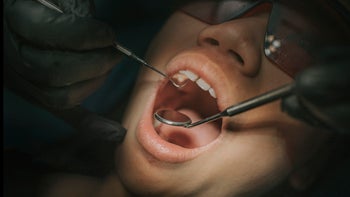
How Much Do Dental Veneers Cost?
Key takeaways:
Composite resin veneers average $800 per tooth or more, depending on how they’re made. Porcelain veneers average $1,500, and ultrathin porcelain laminate ones are about $1,800 each.
Composite veneers last 5 years or so. Porcelain veneers typically hold up at least 10 years.
Because the purpose of veneers is cosmetic, they are not covered by health or dental insurance.

Many people would love to have a beautiful smile full of shapely, pearl-white teeth. But a person’s natural teeth may be irregularly shaped or spaced; teeth may crack, become discolored, or lose enamel with age. If you feel your smile needs a makeover, getting dental veneers — which cover the front surface of the tooth — is a common way to camouflage the flaws.
Permanent veneers are usually made of composite resin, porcelain, or an ultrathin porcelain laminate. Porcelain veneers cost more and last longer than composite ones. Ultrathin veneers are the most expensive type and can stay intact for as long as 20 years.
Read on to learn more about veneer prices as well as information on materials, insurance coverage, and other factors that can affect the cost.
Search and compare options
How much do dental veneers typically cost?
The price of permanent veneers depends on the material used to make them. You can also expect your estimated cost to reflect market prices in your location.
Composite resin: These veneers are the least expensive. Composite resin veneers can be made in the dentist’s office (“chairside”) or in a laboratory. On average, chairside veneers cost around $800 per tooth. Lab-made composite veneers are slightly pricier, averaging $1,100 or so.
Porcelain: These veneers range from $900 to $2,500 apiece, averaging about $1,500. Porcelain veneers are usually 0.5 mm to 1 mm thick, and they are long-lasting (10 to 20 years). The dentist files off a thin layer of your tooth’s enamel to accommodate this type of veneer, meaning the process is irreversible. A veneer that cracks or falls off must be replaced; without it, the tooth will be uncomfortably exposed.
Porcelain laminate: These veneers are ultrathin (0.2 mm to 0.3 mm) and can cost between $800 and $2,000 each, with an average price of $1,800. Their advantage is that the dentist doesn’t always have to remove enamel from your tooth before placement. So, the installation of these veneers is often reversible.
Again, the prices noted above are for a single tooth. You might, though, want to cover eight front teeth, for example, with porcelain veneers. If you paid the national average price per tooth of $1,500, your total would be 8 x $1,500, or $12,000. It’s unlikely that your dentist or prosthodontist offers a discount for multiple teeth, but it’s worth asking.
What else can influence the average cost of dental veneers?
Before getting your veneers, you'll probably need a dental exam and a cleaning. Without insurance, each of these averages $100. If X-rays are required, expect them to cost $35 to $150. If you do have insurance, it’s likely that your policy fully covers two exams and cleanings per year and pays most or all of the price of X-rays.
Variations in cost may also reflect the skill and experience of the dentist and that of the technician who creates the veneers in the lab.
What is the difference between a veneer and a crown?
A crown covers or replaces a whole tooth. It’s typically 2 mm thick and designed to provide protection and strength for the tooth. As part of a bridge or an implant, it can mimic or replace a tooth that has been extracted.
Read more like this
Explore these related articles, suggested for readers like you.
A veneer is half the thickness of a crown — just 1 mm, or even thinner. The purpose of a veneer is to improve the appearance of one or more teeth. Like crowns, veneers can be used on front teeth that are chipped or cracked. Unlike crowns, they are not used after a root canal or other significant damage to a tooth.
What to expect when getting dental veneers
The process of getting porcelain or lab-made composite veneers requires two visits to the dentist, several weeks apart. Each visit may last hours.
In the first visit, you and the dentist will discuss any underlying dental health issues that need to be addressed. Together, you two will choose your veneers’ material and their shade of white.
The dentist will give you a local anesthetic, prepare each tooth by filing away a thin layer of the front enamel, and then take impressions of your teeth for reference. Removing some enamel makes room for the veneer and provides a surface for the adhesive to bond to. The alteration also makes most veneers irreversible.
The dentist will fit you with temporary veneers to wear until the lab has finished making the permanent ones. During that time, the removal of enamel may leave your teeth more sensitive to hot and cold.
On your second visit, the dentist will remove the temporary veneers and use a special glue to attach the permanent veneers to your teeth.
If you’re getting ultrathin laminate veneers — sometimes described as “no-prep” veneers — the dentist usually won’t need to remove any enamel before placement.
Composite veneers may be fabricated in a lab, or they may be made “chairside.” Chairside veneers can be produced with digital scans and in-office milling equipment. Or, the dentist can create them by directly applying the resin to the prepared teeth. The dentist adds composite resin and bonding agent, shapes the resin, cures it with a high-intensity light, and then does a final polishing to finish the process. With chairside methods, your dentist can create and install your veneers on the same day.
Is getting dental veneers worth it?
The cost of dental veneers can total thousands of dollars. As with any cosmetic procedure, insurance will not cover it. Whether that cost is worth it depends on why you choose to get the veneers.
For some people, like actors, news anchors, and public speakers, veneers can be a career investment. For others, veneers can help them feel more comfortable in social situations. Having more confidence is valuable in itself.
In terms of dollars and cents, though, the benefit of getting veneers is hard to calculate.
One plus is that porcelain veneers resist stains, so they’ll stay white. This means you won’t need whitening treatments, which may save you some cash. (No such luck with composite veneers; like your natural tooth enamel, those can be stained by coffee, tea, or red wine.)
Bear in mind that if you get irreversible veneers, you’ll eventually need to repair or replace them. Depending on the type you get, that will happen after 5 to 20 years. The cost will likely be higher in the future due to inflation or other factors. So, you’ll want to figure the price of those replacements into the total cost of getting veneers.
Does my health or dental insurance cover dental veneers?
Health insurance usually doesn’t cover dental care unless it’s found to be medically necessary. And neither health nor dental insurance plans cover cosmetic procedures.
One way to save money on veneers is with a dental savings plan, also called a dental discount plan. In exchange for a monthly or annual membership fee, discount dental plans offer services from in-network providers at discounted rates, often without a waiting period. CignaPlus Savings, for example, advertises a 21% discount on composite veneers and a 31% discount on porcelain ones.
These plans are not insurance, so be sure to read the fine print and consider your actual needs.
Can I finance dental veneers?
Many dentists offer payment plans. Companies such as Care Credit and American Medical Loans offer dental financing, too.
In addition to noting the interest rate they offer, you’ll want to ask the lender about processing fees and any effect the loan may have on your credit score.
The bottom line
Dental veneers cost between $800 and $1,800 per tooth, on average, depending on the material used. Multiplying that cost by the number of teeth to be treated means that dental veneers get expensive quickly.
Veneers are a cosmetic treatment, so they are not covered by insurance. However, they could last up to 20 years before needing to be replaced.
Why trust our experts?


References
American Academy of Cosmetic Dentistry. (n.d.). Porcelain veneers.
American College of Prosthodontists. (n.d.). Dental veneers FAQ.
American Dental Association. (n.d.). Patient financing options.
Canadian Dental Association. (n.d.). Bonding & veneers.
Colgate-Palmolive Company. (n.d.). Can you whiten veneers?
Consumer Guide to Dentistry. (n.d.). Dental insurance: Plan comparison and coverage guide.
Consumer Guide to Dentistry. (n.d.). Lumineers, Durathin, Vivaneers and other minimal and “no-prep” veneers.
Consumer Guide to Dentistry. (2021). Porcelain veneers - Procedure costs & recovery.
DentalPlans.com. (n.d.). CignaPlus Savings.
DentalPlans.com. (n.d.). Discount dental care with dental savings plans.
McKenna, N., et al. (2021). Discount dental plans: A simple solution to cut your dental bills in half.
Authority Dental.Moryoussef, E., et al. (2022). How much do veneers cost? Averages prices of dental veneers. Authority Dental.




























